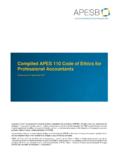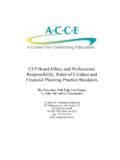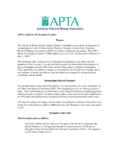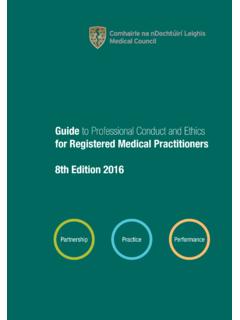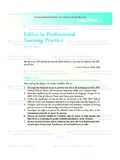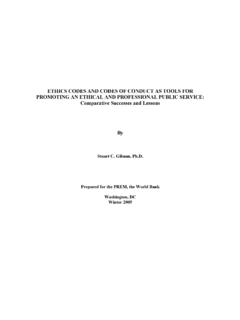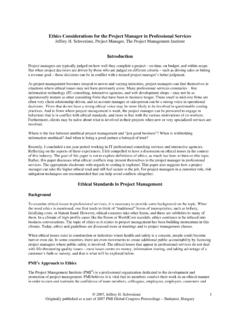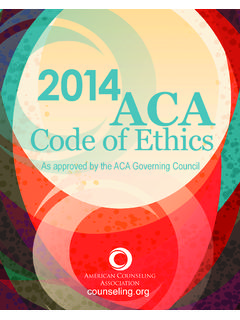Transcription of Code of Ethics and Professional Conduct - WHO
1 Code of Ethics and Professional Conduct April 2017 Code of Ethics and Professional Conduct 2 Acknowledgements This document was prepared by the Office of Compliance, Risk Management and Ethics (CRE) of WHO. CRE s objective is to pursue excellence at all levels of WHO in an effective, efficient, transparent and accountable way by promoting and upholding the highest organizational standards, ethical principles and Conduct . The content has been enriched thanks to contributions and inputs from across WHO collected through the all staff consultation process held between December 2016 and January 2017. Disclaimer This document is provided for information only, for the purpose of transparency, and includes references to other internal WHO documents, which may not be accessible.
2 It should not be reproduced. Code of Ethics and Professional Conduct 3 Table of contents Contents 1. Glossary and links .. 5 2. Introduction: Fostering ethical behaviour .. 9 3. Welcome to WHO .. 9 Oath of office .. 10 WHO s ethical principles .. 10 Ethical Principles in practice .. 10 The individual .. 12 The Manager/Supervisor .. 13 The Organization .. 13 4. WHO organizational commitments .. 14 Fair and respectful workplace .. 14 No disrespect .. 15 No discrimination and no favouritism .. 16 No abuse of authority/power .. 17 No harassment .. 18 No sexual harassment .. 20 Fair and respectful provision of feedback on performance .. 21 Prevention of sexual exploitation and abuse .. 22 Human rights and humanitarian contexts .. 23 Child protection .. 24 Gender equity and equality.
3 24 Work-life balance .. 25 Scientific Conduct and 25 Fair and transparent procurement .. 26 5. Personal Conduct .. 27 Respect for national laws .. 27 Violence in the workplace, drug and alcohol abuse, smoke-free environment .. 28 Personal relationships in the workplace .. 28 Hiring of spouses and other family members .. 29 Domestic abuse and intimate partner violence .. 29 Domestic Workers .. 30 Conflict of interest .. 30 Code of Ethics and Professional Conduct 4 Definitions .. 30 Declarations of Interest for WHO staff members .. 31 Declarations of interest when interacting with external experts and consultants .. 32 Relations with governments and political activity .. 32 Relations with non-State actors .. 33 Right of association .. 34 Outside activities .. 34 Acceptance of gifts, decorations and honours.
4 35 Post-employment obligations .. 35 Use of WHO property and resources .. 36 Use of official time and office 36 Accuracy of records .. 36 Use of information, publications and media .. 36 Use and protection of information .. 36 Intellectual property, publications .. 37 Media relations and public statements .. 37 Emails and Social media .. 38 6. Reporting wrongdoing .. 39 Informal processes .. 39 Whistleblowing and Protection against retaliation .. 39 Duty to comply and disciplinary measures .. 40 7. Final Note .. 40 Code of Ethics and Professional Conduct 5 1. Glossary and links Acceptable Use of Information and Communication Systems outlines entitlements and responsibilities for the acceptable use of the information and communications systems at WHO. Accountability Framework acts as an enabler by providing the overall architecture for accountability in the Organization and defining what it entails.
5 It is guided by seven core principles of accountability, which form its foundation and provide the basis for implementing accountability policies, processes, and tools. Beneficiary population refers to the people WHO works with and/or serves or seeks to assist across the world, who are typically in situations of vulnerability and dependence vis vis WHO staff. Beneficiaries are individuals who are direct or indirect recipients of humanitarian/emergency or other WHO action in any duty station. Among such individuals, women and children are particularly at risk of sexual exploitation and abuse (SEA). Child a "human being below the age of eighteen years"1. Clearance procedures for publications lays out the procedures for all proposals for publications to be issued by WHO to be cleared before development begins.
6 Code of Conduct for Responsible Research provides a standard to assist WHO staff in carrying out the Organization s mission regarding health research. It provides general principles and standards for good practice in the Conduct of research, applicable to all staff engaged in research under the auspices of the WHO. Code of Conduct for the Election of the Director-General of the World Health Organization aims at promoting an open, fair, equitable and transparent process for the election of the Director-General of the World Health Organization. In seeking to improve the overall process, the code addresses several areas, including the submission of proposals, the Conduct of electoral campaigns by Member States and candidates, as well as funding and financial matters.
7 Collaborators individuals who work for WHO as non-staff members including consultants, holders of Agreements for Performance of Work (APW), Technical Services Agreement (TSA) holders, Special Service Agreements (SSA) or letters of agreement, Temporary Advisers, Interns, and Volunteers, as well as third party entities such as vendors, contractors or technical partners who have a contractual relationship with WHO. Country Cooperation Strategy 2016 Guide presents the essential steps in the preparation of a Country Cooperation Strategy, WHO s medium-term strategic vision to guide the Organization s work in and with a country. Declaration of interest for staff members form that WHO staff members in designated functions are requested to complete annually to declare any interest that may conflict with their work at WHO.
8 Declaration of interest for experts form that external experts are requested to complete before they can initiate their collaboration with WHO. External experts are asked to declare any circumstance that could represent a conflict of interest related to their expertise. 1 Convention on the Rights of the Child (General Assembly resolution 44/25 of 20 November 1989). Code of Ethics and Professional Conduct 6 Financial regulations and financial rules The Financial Regulations govern the financial administration of the Organization. The Financial Rules are established by the Director-General, including relevant guidelines and limits for the implementation of the Financial Regulations, in order to ensure effective financial administration, the exercise of economy, and safeguard of the assets of the Organization.
9 Framework on Engagement with non-State Actors enables WHO s engagement with non-State actors (nongovernmental organizations, private sector entities, philanthropic foundations, and academic institutions) and serves also as an instrument to identify the risks, balancing them against the expected benefits, while protecting and preserving WHO s integrity, reputation and public health mandate. Fraud Prevention Policy and Fraud Awareness Guidelines defines fraud as "misappropriation, irregularities and illegal acts characterized by deceit, concealment or violation of trust", and establishes an investigation process. Gender Equality Staffing Policy commits WHO to achieving at least a increase in the percentage of female staff at P4 and above, every year for the next five years in the Organization, taking into account and monitoring the different levels of progress made by HQ and Regional Offices.
10 Guidelines for Declaration of Interests explain the meaning of a "conflict of interest"; identify when an external expert must complete a declaration of interests form ("DOI Form"); explain how the WHO Secretariat through the relevant technical unit (the Secretariat ), should assess the information disclosed; and describe what actions should be taken when a potential conflict appears to exist. The Guidelines also describe the Public Notice and Comment procedure and provide a listing of practical considerations relating to the selection of experts and the management of conflicts of interest Handbook for Guideline Development provides step-by-step guidance on how to plan, develop and publish a World Health Organization (WHO) guideline.










